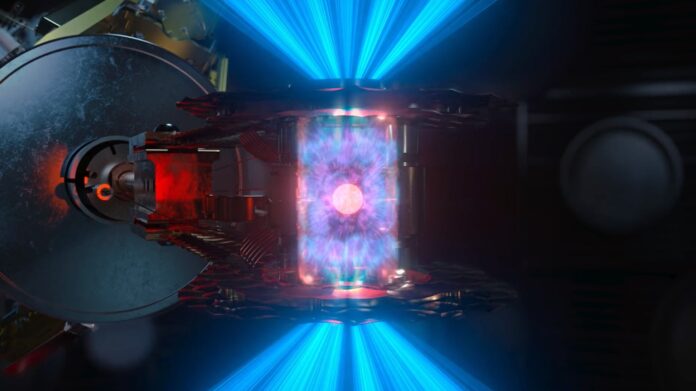For the first time, a US lab has created a fusion reaction that produced more energy than it took to start the reaction.
On Tuesday, the US Department of Energy confirmed(Opens in a new window) the research breakthrough, which promises to help humanity end its reliance on fossil fuels and replace them with clean energy that replicates power from the Sun.
The breakthrough was achieved at the Lawrence Livermore National Laboratory near San Francisco. The same lab is home to a 10-story building called the National Ignition Facility(Opens in a new window), which is about the size of three football fields and contains 192 lasers designed to achieve a fusion reaction. The technology does this by bombarding a pellet of hydrogen isotopes at extremely high temperatures to cause them to fuse, releasing energy.
The target chamber of lab’s National Ignition Facility.
(Credit: Lawrence Livermore National Lab)
Although the facility has been able to achieve fusion reactions before, the results could never produce more energy than the lasers emit. But on Dec. 5, a team managed to create a fusion reaction that required only 2.05 megajoules of laser energy while producing 3.15 megajoules of fusion energy output for a net gain.
The lasers heated the capsule of hydrogen isotopes to over 3 million degrees Celsius, “briefly simulating the conditions of a star,” said Jill Hruby, the administrator at the National Nuclear Security Administration (NNSA), an agency under the Department of Energy.
The lasers being shot through the cylinder.
(Credit: Lawrence Livermore National Lab)
In a press conference(Opens in a new window), US officials said the lasers were fired through a cylinder carrying the capsule of hydrogen, and ended up striking the cylinder’s inner wall. “X-rays from the wall impinged on the spherical capsule, fusion fuel from the capsule got squeezed, fusion reaction started,” said Marv Adams, NNSA’s deputy administrator for defense programs.
The lab had conducted hundreds of similar experiments before. But this time, researchers were able to design the experiment to ensure the fusion fuel inside “remained hot enough, dense enough, round enough for long enough that it ignited and produced more energy than the lasers had deposited,” Adams said.
“The energy production took less time than it takes for light to travel one inch,” he added, essentially lasting only for a few billionths of a second.
Recommended by Our Editors
However, US officials say the breakthrough is just a first step in turning fusion power into a mainstream power source. Kim Budil, director for the Lawrence Livermore National Laboratory, projected it’ll take “decades” before the lab’s fusion energy becomes commercialized, but probably less than 50 years.
“This is one igniting capsule, one time. And to realize commercial fusion energy you have to do many things. You have to produce many, many fusion ignition events per minute. And you have to have a robust system of drivers to enable that,” she said.
Budil also pointed out that the 192 lasers required over 300 megajoules of electricity to produce an output of 2.05 megajoules to heat the pellet of hydrogen. Hence, researchers will need to make the laser system far more energy-efficient or create a larger fusion energy output in order to commercialize the technology.
Get Our Best Stories!
Sign up for What’s New Now to get our top stories delivered to your inbox every morning.
This newsletter may contain advertising, deals, or affiliate links. Subscribing to a newsletter indicates your consent to our Terms of Use and Privacy Policy. You may unsubscribe from the newsletters at any time.
Hits: 0

















